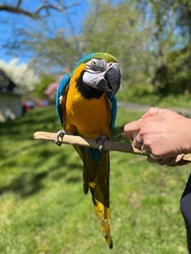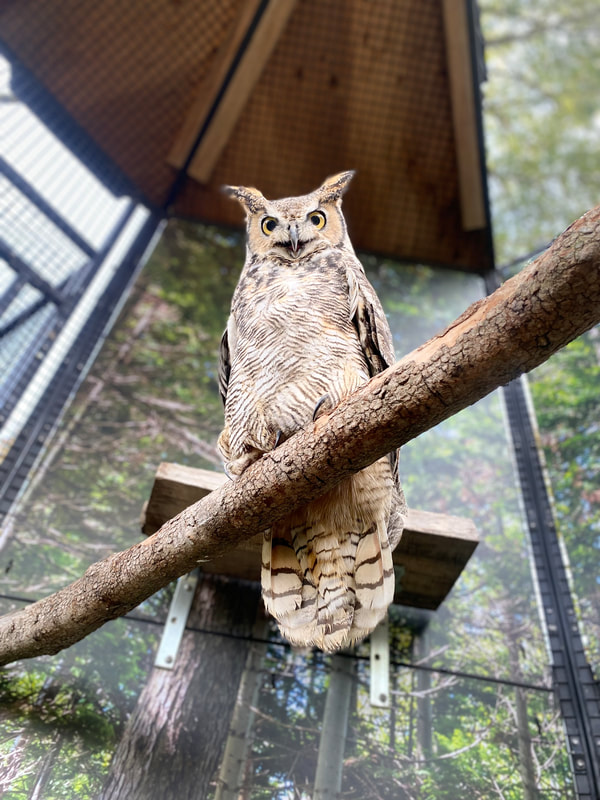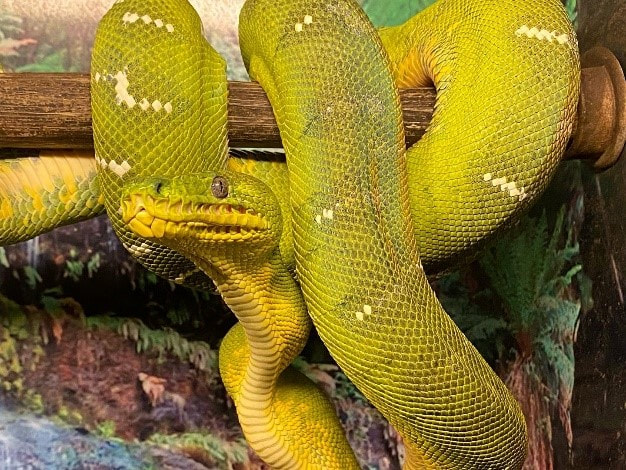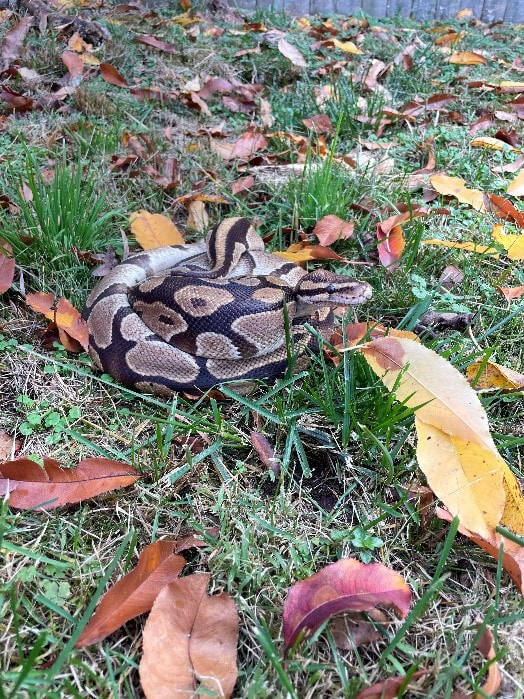Written By: Zoe Glover |
| Amur (Siberian) tiger (Panthera tigris altaica) Photo credit- Jack Bradley Amur tigers, formally known as Siberian tigers, are a critically endangered subspecies of tiger, with less than 500 individuals remaining in the wild. Threats to this species include poaching, loss of prey, and habitat fragmentation. Hunting was common in Russia, with an estimated 150 individuals being killed each year during the late 1800s. In 1947, the country put a ban on hunting these big cats [3]. Main prey of the Amur tiger includes deer and wild boar. A decrease in these key prey species due to illegal hunting has contributed to Amur tiger population decrease. Additionally, habitat fragmentation for logging and development has decreased the areas in which Amur tigers can live. Today, wild Amur tigers are found in the Russian Far East, a small part of their previous range, which included the Korean Peninsula, Northeast China, and Northeast Mongolia [3]. Here at the zoo, we have Changbai, a female Amur tiger who is part of the Species Survival Plan (SSP) program, a breeding program which encourages population health and stability. |
| Red panda (Ailurus fulgens fulgens) Photo credit- Emma Carney Red pandas are an endangered species, as the population is decreasing due to habitat loss and poaching. This species is found in high-altitude mountain forests and bamboo thickets in south Central Asia. Forests and bamboo are being cleared for development and agriculture, which is not only impacting their home, but their main food source of the roots and shoots of bamboo [4]. Poaching is common in China and Myanmar for their pelts, with headwear being found in Bhutan [5]. Here at the zoo, we have a female red panda named Berry, who you can see in the Natt Family Red Panda Habitat or on the Zoo Cam. |
| Blue and gold macaw (Ara ararauna) Photo credit- Lauren Tiroletto Blue and Gold Macaws are commonly found in rainforests in Mexico, Central America, and northern South America. While they are of least concern, their population is decreasing due to habitat loss and fragmentation for agriculture and development, which is causing a decline in nesting sites. Additionally, they are poached by the illegal pet trade. Here at the zoo, we have Newton, an Ambassador Animal, who has a wonderful bond with some of the education staff! She, along with the other ambassador animals in the education department are handled by staff for programs and outreach, which helps to support our zoo mission in education and conservation. Be sure to look for her on programs. |
| Great horned owl (Bubo virginianus) Photo credit- Chrissy Shore and Lauren Tiroletto Great Horned Owls are common, but like other owls, are protected under U.S. law such as the U.S. Migratory Bird Treaty Act. They are found in all of North, Central, and South America, except the West Indies. While not necessarily threatened, eggs, young, and adults can face threats. Eggs and young can be subject to predation by foxes, racoons, ravens, and other raptors, while adults can be harmed by rodent prey that has been poisoned and by collisions with cars and fences [6], [7]. You can see our Ambassador Great Horned Owl, Ohundum, in the Upper Farmyard. Be sure to admire her beautiful and prominent yellow eyes! |
| Emerald tree boa (Corallus caninus) Photo credit- Connecticut's AAZK Chapter Emerald tree boas are commonly found in the Amazon Basin region of Colombia, Ecuador, Peru, Brazil, and from Venezuela to Surinam and the Guianas. While they are of least concern, the main threats to this species include habitat loss and poaching by the illegal pet trade. Habitat maintenance is important, as this species is arboreal and relies on trees to live and camouflage. Here at the zoo, we have Washington, who can be found in the Rainforest Building. |
| Ball python (Python regius) Photo credit- Zoe Glover Ball pythons are commonly found in the Sub-Saharan Africa from the West coast of Senegal, Cot D'Ivoire Ghana Eastwards toward Chad, Sudan, Cameroon, and Uganda up to the Nile River [8]. Their habitats include grasslands and scattered forests. While they are of least concern, the main threats to this species include habitat loss and poaching by the illegal pet trade. Here at the zoo, we have two Ambassador ball pythons, Linus, and Lucy. Be sure to look out for them on programs. |
[1]- https://cites.org/eng/disc/what.php
[2]- https://www.wildlifeday.org/en
[3]- https://russia.wcs.org/en-us/Wildlife/Amur-Tigers/Amur-Tiger-Ecology.aspx
[4]- https://redpandanetwork.org/Threats
[5]- https://www.worldwildlife.org/species/red-panda
[6]- https://www.chesapeakebay.net/discover/field-guide/entry/great-horned-owl
[7]- https://abcbirds.org/bird/great-horned-owl/
[8]- https://www.oaklandzoo.org/animals/ball-royal-python
Thank you so much for sharing this! It is so inspiring and we got a lot of ideas. This is also a must read for all people who's looking for an <a href="https://www.windsongtagaytay.com" title="event's place" alt="event's place">event's place</a> that is perfect for any kind of occasion. Kudos!
Thank you for your kind reply. I am happy to hear that this blog was useful to you!
I'm thrilled that World Wildlife Day on March 3, 2023, is just around the corner! It's the perfect occasion to celebrate the magnificent creatures that share our planet and to reflect on the importance of preserving their habitats and well-being.
Rocky Mountain Oils' "At Peace" is a soothing essential oil blend that offers tranquility and relaxation. Crafted with a harmonious combination of essential oils, it promotes a sense of calm and emotional balance when diffused or applied topically. "At Peace" is the perfect choice for those seeking a peaceful and serene atmosphere in their daily lives.
The annual observance of World Wildlife Day serves as a reminder of our shared responsibility to protect and preserve the diversity of life on our planet. The survival of countless species depends on the diligent enforcement of CITES and the global commitment to combat illegal wildlife trade.
MHM Casino is a cutting-edge online casino that exclusively operates with cryptocurrencies, offering players a secure and anonymous gambling experience using digital assets.
With MHM Casino's casino cryptocurrency system, players can enjoy a wide range of games while benefiting from the advantages of blockchain technology, such as fast transactions and provably fair gaming outcomes.
Leave a Reply.
Archives
July 2024
June 2024
May 2024
March 2024
February 2024
December 2023
November 2023
October 2023
September 2023
July 2023
June 2023
May 2023
April 2023
March 2023
February 2023
January 2023
October 2022
September 2022
July 2022
January 2022
September 2021
March 2021
February 2021
January 2021
December 2020
July 2020
June 2020
April 2020
March 2020







 RSS Feed
RSS Feed





